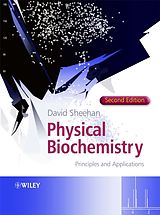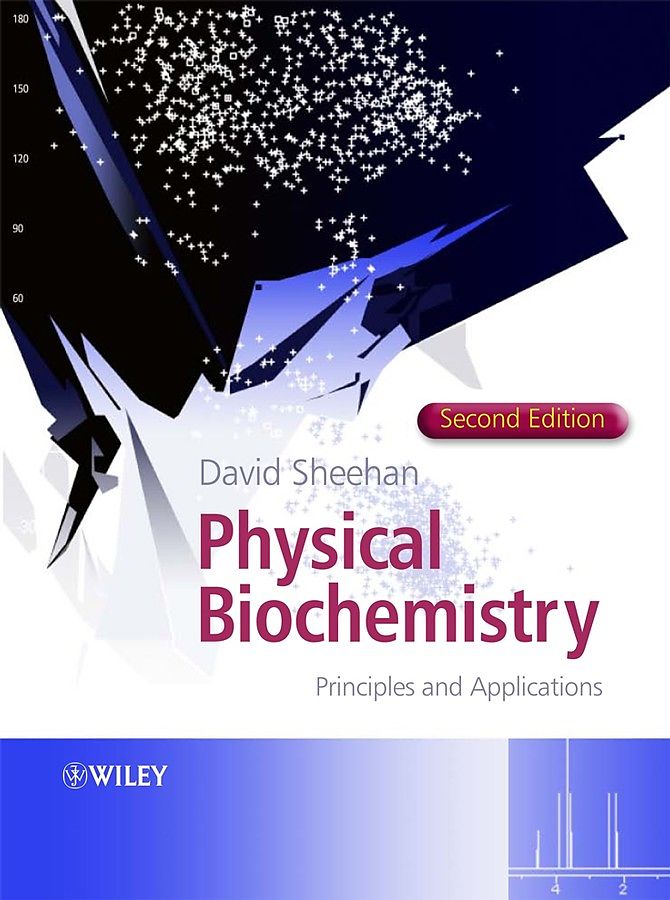Physical Biochemistry
Format:
E-Book (EPUB)
EAN:
9781118687482
Untertitel:
Principles and Applications
Genre:
Sonstiges
Autor:
David Sheehan
Herausgeber:
Wiley
Auflage:
2. Aufl.
Anzahl Seiten:
328
Erscheinungsdatum:
30.04.2013
ISBN:
978-1-118-68748-2
"As will be seen, there is not much missing here. I thought that
the sections were well balanced, with rarely too much or too little
on a given topic...This is a text to be welcomed by both teachers
and students." BIOCHEMISTRY & MOLECULAR BIOLOGY EDUCATION
(on the first edition)
The second edition of this successful textbook explains the
basic principles behind the key techniques currently used in the
modern biochemical laboratory and describes the pros and cons of
each technique and compares one to another. It is non-mathematical,
comprehensive and approachable for students who are not physical
chemists.
* A major update of this comprehensive, accessible introduction
to physical biochemistry.
* Includes two new chapters on proteomics and
bioinformatics.
* Introduces experimental approaches with a minimum of
mathematics and numerous practical examples.
* Provides a bibliography at the end of each chapter.
Written by an author with many years teaching and research
experience, this text is a must-have for students of
biochemistry, biophysics, molecular and life sciences and food
science.
Autorentext
DAVID SHEEHAN, University College Cork, Ireland.
Klappentext
The second edition of this successful textbook explains the basic principles behind the key techniques currently used in the modern biochemical laboratory and describes the pros and cons of each technique and compares one to another. It is non-mathematical, comprehensive and approachable for students who are not physical chemists. • A major update of this comprehensive, accessible introduction to physical biochemistry. • Includes two new chapters on proteomics and bioinformatics. • Introduces experimental approaches with a minimum of mathematics and numerous practical examples. • Provides a bibliography at the end of each chapter Written by an author with many years teaching and research experience, Physical Biochemistry: Principles and Applications, Second Edition will prove invaluable to students of biochemistry, biophysics, molecular and life sciences and food science.
Zusammenfassung
"As will be seen, there is not much missing here. I thought that the sections were well balanced, with rarely too much or too little on a given topic...This is a text to be welcomed by both teachers and students." BIOCHEMISTRY & MOLECULAR BIOLOGY EDUCATION (on the first edition) The second edition of this successful textbook explains the basic principles behind the key techniques currently used in the modern biochemical laboratory and describes the pros and cons of each technique and compares one to another. It is non-mathematical, comprehensive and approachable for students who are not physical chemists. A major update of this comprehensive, accessible introduction to physical biochemistry. Includes two new chapters on proteomics and bioinformatics. Introduces experimental approaches with a minimum of mathematics and numerous practical examples. Provides a bibliography at the end of each chapter. Written by an author with many years teaching and research experience, this text is a must-have for students of biochemistry, biophysics, molecular and life sciences and food science.
Inhalt
Preface. Chapter 1 Introduction. 1.1 Special Chemical Requirements of Biomolecules. 1.2 Factors Affecting Analyte Structure and Stability. 1.3 Buffering Systems Used in Biochemistry. 1.4 Quantitation, Units and Data Handling. 1.5 The Worldwide Web as a Resource in Physical Biochemistry. 1.6 Objectives of this Volume. References. Chapter 2 Chromatography. 2.1 Principles of Chromatography. 2.2 Performance Parameters Used in Chromatography. 2.3 Chromatography Equipment. 2.4 Modes of Chromatography. 2.5 Open Column Chromatography. 2.6 High Performance Liquid Chromatography (HPLC). 2.7 Fast Protein Liquid Chromatography. 2.8 Perfusion Chromatography. 2.9 Membrane-Based Chromatography Systems. 2.10 Chromatography of a Sample Protein. References. Chapter 3 Spectroscopic Techniques. 3.1 The Nature of Light. 3.2 The Electromagnetic Spectrum. 3.3 Ultraviolet/Visible Absorption Spectroscopy. 3.4 Fluorescence Spectroscopy. 3.5 Spectroscopic Techniques Using Plane-Polarized Light. 3.6 Infrared Spectroscopy. 3.7 Nuclear Magnetic Resonance (NMR) Spectroscopy. 3.8 Electron Spin Resonance (ESR) Spectroscopy. 3.9 Lasers. 3.10 Surface Plasmon Resonance. References. Chapter 4 Mass Spectrometry. 4.1 Principles of Mass Spectrometry. 4.2 Mass Spectrometry of Proteins/Peptides. 4.3 Interfacing MS with other Methods. 4.4 Uses of Mass Spectrometry in Biochemistry. References. Chapter 5 Electrophoresis. 5.1 Principles of Electrophoresis. 5.2 Nondenaturing Electrophoresis. 5.3 Denaturing Electrophoresis. 5.4 Electrophoresis in DNA Sequencing. 5.5 Isoelectric Focusing (IEF). 5.6 Immunoelectrophoresis. 5.7 Agarose Gel Electrophoresis of Nucleic Acids. 5.8 Pulsed Field Gel Electrophoresis. 5.9 Capillary Electrophoresis. 5.10 Electroblotting Procedures. 5.11 Electroporation. References. Chapter 6 Three-Dimensional Structure Determination of Macromolecules. 6.1 The Protein-Folding Problem. 6.2 Structure Determination by NMR. 6.3 Crystallization of Biomacromolecules. 6.4 X-Ray Diffraction by Crystals. 6.5 Calculation of Electron Density Maps. 6.6 Other Diffraction Methods. 6.7 Comparison of X-Ray Crystallography with Multi-Dimensional NMR. 6.8 Structural Databases. References. Chapter 7 Hydrodynamic Methods. 7.1 Viscosity. 7.2 Sedimentation. 7.3 Methods for Varying Buffer Conditions. 7.4 Flow Cytometry. References. Chapter 8 Biocalorimetry. 8.1 The Main Thermodynamic Parameters. 8.2 Isothermal Titration Calorimetry. 8.3 Differential Scanning Calorimetry. 8.4 Determination of Thermodynamic Parameters by Non-Calorimetric Means. References. Chapter 9 Bioinformatics. 9.1 Overview of Bioinformatics. 9.2 Sequence Databases. 9.3 Tools for Analysis of Primary Structures. 9.4 Tertiary Structure Databases. 9.5 Programs for Analysis and Visualization of Tertiary Structure Databases. 9.6 Homology Modelling. References. Chapter 10 Proteomics. 10.1 Electrophoresis in Proteomics. 10.2 Mass Spectrometry in Proteomics. 10.3 Chip Technologies in Proteomics. 10.4 Post-Translational Modification Proteomics. Further Reading. References. Appendix 1 SI Units. ...

Leider konnten wir für diesen Artikel keine Preise ermitteln ...
billigbuch.ch sucht jetzt für Sie die besten Angebote ...
Die aktuellen Verkaufspreise von 3 Onlineshops werden in Realtime abgefragt.
Sie können das gewünschte Produkt anschliessend direkt beim Anbieter Ihrer Wahl bestellen.
Loading...
Die aktuellen Verkaufspreise von 3 Onlineshops werden in Realtime abgefragt.
Sie können das gewünschte Produkt anschliessend direkt beim Anbieter Ihrer Wahl bestellen.
| # | Onlineshop | Preis CHF | Versand CHF | Total CHF | ||
|---|---|---|---|---|---|---|
| 1 | Seller | 0.00 | 0.00 | 0.00 |
